Annotated Bibliography: Year-Round Schooling, Impact, and Achievement
VerifiedAdded on 2023/06/03
|6
|1449
|232
Annotated Bibliography
AI Summary
This annotated bibliography provides a detailed overview of several research articles focusing on the effects of year-round schooling versus the traditional nine-month school calendar. The articles explore various aspects, including student achievement, teacher turnover, and economic impacts. One article compares student performance in year-round versus nine-month schools, considering racial factors. Another examines teacher turnover and quality in year-round schools, linking it to area affluence. A third article questions the desirability of year-round schooling, while another analyzes the employment opportunities for teachers in both systems. Finally, one study addresses the negative impact of long summer vacations on mathematical aptitude. Each annotation summarizes the research question, methodology, findings, and limitations of the respective article, offering a comprehensive perspective on the debate surrounding year-round schooling. This document is available on Desklib, where students can find a wealth of academic resources.
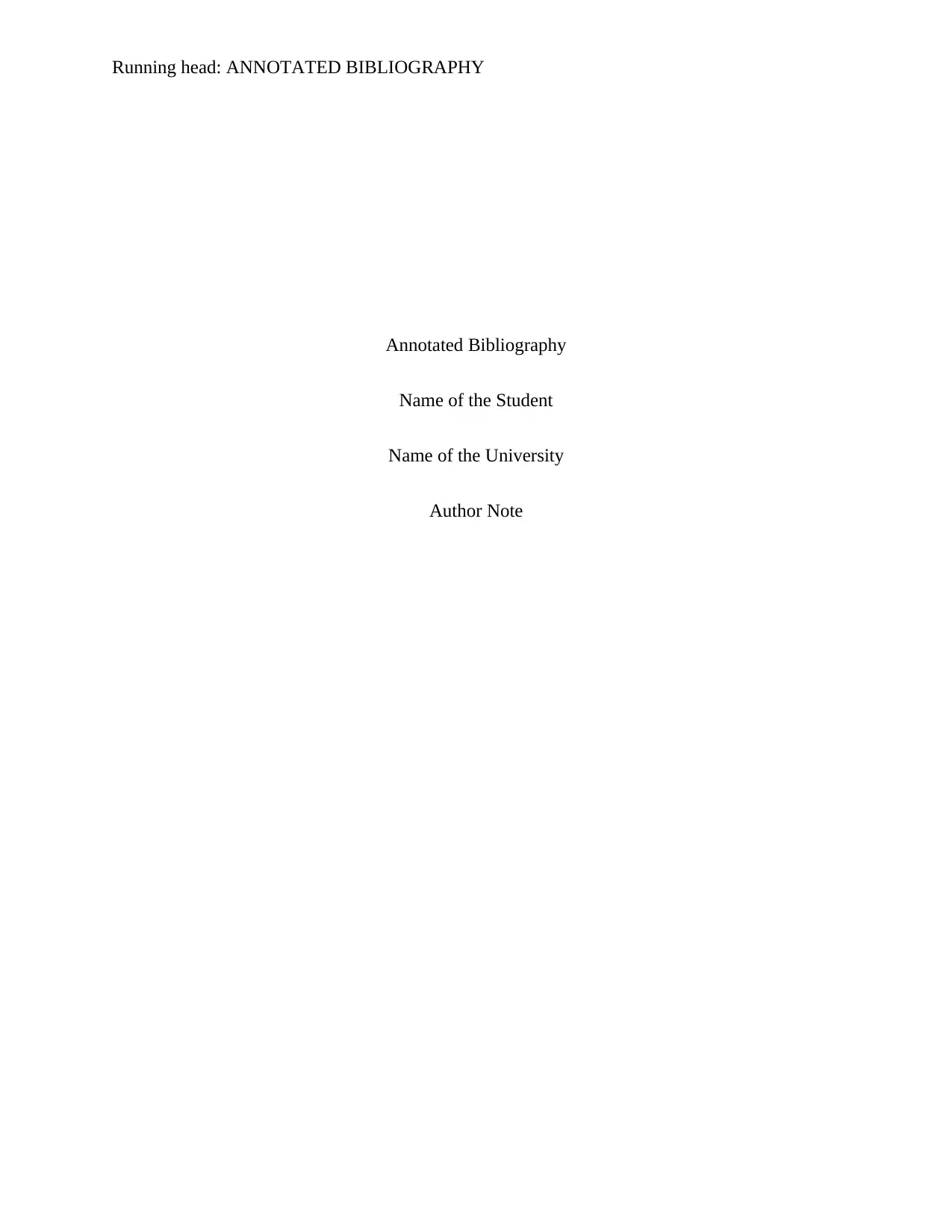
Running head: ANNOTATED BIBLIOGRAPHY
Annotated Bibliography
Name of the Student
Name of the University
Author Note
Annotated Bibliography
Name of the Student
Name of the University
Author Note
Paraphrase This Document
Need a fresh take? Get an instant paraphrase of this document with our AI Paraphraser
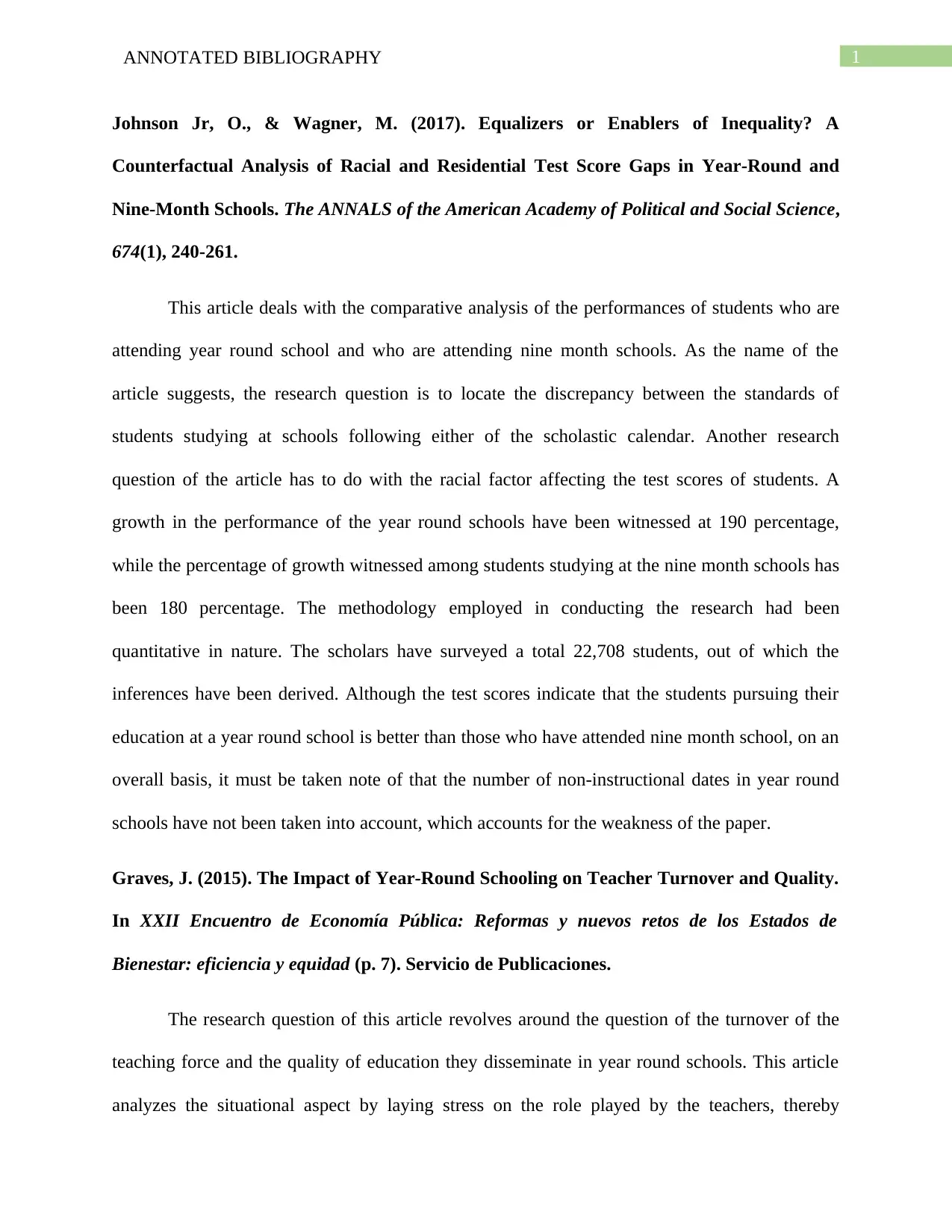
1ANNOTATED BIBLIOGRAPHY
Johnson Jr, O., & Wagner, M. (2017). Equalizers or Enablers of Inequality? A
Counterfactual Analysis of Racial and Residential Test Score Gaps in Year-Round and
Nine-Month Schools. The ANNALS of the American Academy of Political and Social Science,
674(1), 240-261.
This article deals with the comparative analysis of the performances of students who are
attending year round school and who are attending nine month schools. As the name of the
article suggests, the research question is to locate the discrepancy between the standards of
students studying at schools following either of the scholastic calendar. Another research
question of the article has to do with the racial factor affecting the test scores of students. A
growth in the performance of the year round schools have been witnessed at 190 percentage,
while the percentage of growth witnessed among students studying at the nine month schools has
been 180 percentage. The methodology employed in conducting the research had been
quantitative in nature. The scholars have surveyed a total 22,708 students, out of which the
inferences have been derived. Although the test scores indicate that the students pursuing their
education at a year round school is better than those who have attended nine month school, on an
overall basis, it must be taken note of that the number of non-instructional dates in year round
schools have not been taken into account, which accounts for the weakness of the paper.
Graves, J. (2015). The Impact of Year-Round Schooling on Teacher Turnover and Quality.
In XXII Encuentro de Economía Pública: Reformas y nuevos retos de los Estados de
Bienestar: eficiencia y equidad (p. 7). Servicio de Publicaciones.
The research question of this article revolves around the question of the turnover of the
teaching force and the quality of education they disseminate in year round schools. This article
analyzes the situational aspect by laying stress on the role played by the teachers, thereby
Johnson Jr, O., & Wagner, M. (2017). Equalizers or Enablers of Inequality? A
Counterfactual Analysis of Racial and Residential Test Score Gaps in Year-Round and
Nine-Month Schools. The ANNALS of the American Academy of Political and Social Science,
674(1), 240-261.
This article deals with the comparative analysis of the performances of students who are
attending year round school and who are attending nine month schools. As the name of the
article suggests, the research question is to locate the discrepancy between the standards of
students studying at schools following either of the scholastic calendar. Another research
question of the article has to do with the racial factor affecting the test scores of students. A
growth in the performance of the year round schools have been witnessed at 190 percentage,
while the percentage of growth witnessed among students studying at the nine month schools has
been 180 percentage. The methodology employed in conducting the research had been
quantitative in nature. The scholars have surveyed a total 22,708 students, out of which the
inferences have been derived. Although the test scores indicate that the students pursuing their
education at a year round school is better than those who have attended nine month school, on an
overall basis, it must be taken note of that the number of non-instructional dates in year round
schools have not been taken into account, which accounts for the weakness of the paper.
Graves, J. (2015). The Impact of Year-Round Schooling on Teacher Turnover and Quality.
In XXII Encuentro de Economía Pública: Reformas y nuevos retos de los Estados de
Bienestar: eficiencia y equidad (p. 7). Servicio de Publicaciones.
The research question of this article revolves around the question of the turnover of the
teaching force and the quality of education they disseminate in year round schools. This article
analyzes the situational aspect by laying stress on the role played by the teachers, thereby
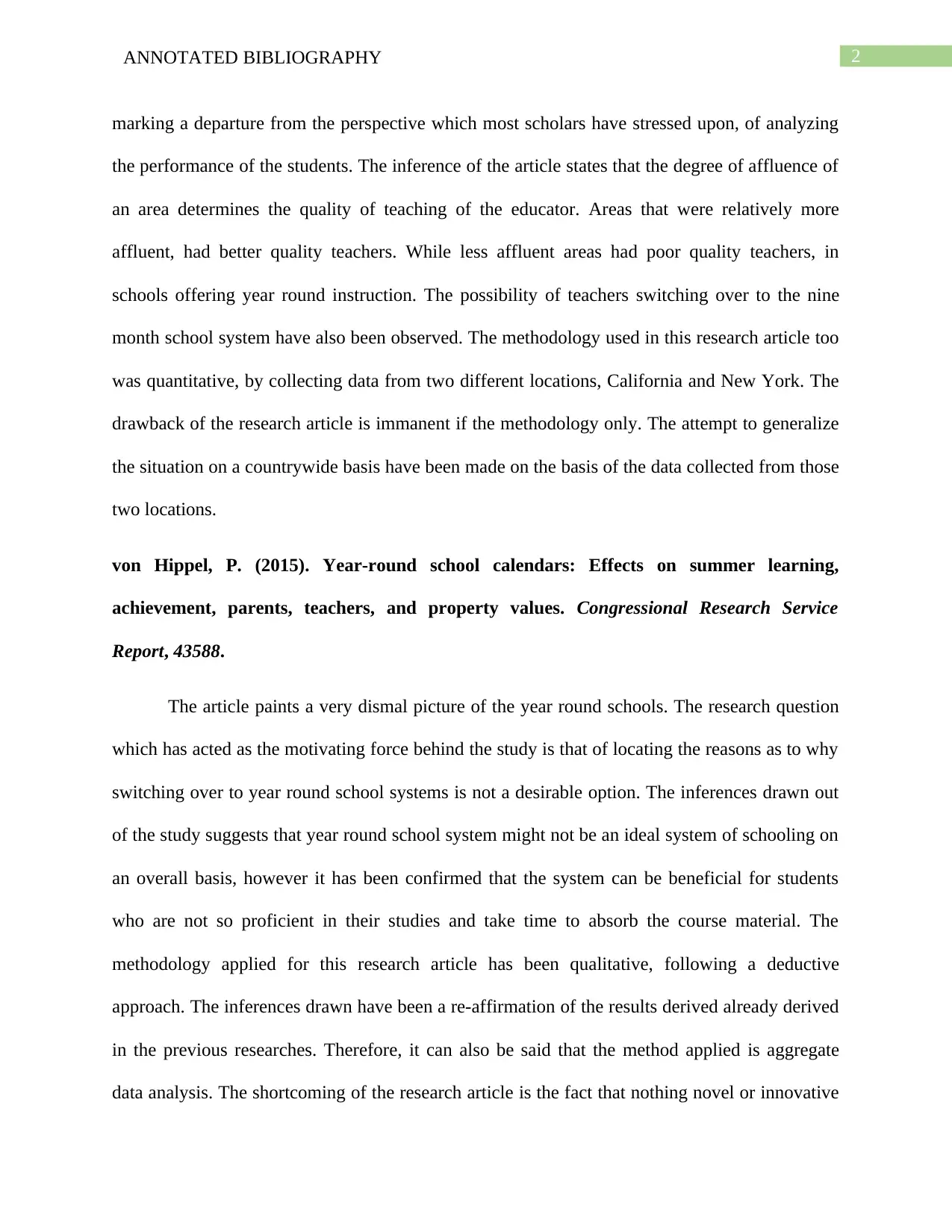
2ANNOTATED BIBLIOGRAPHY
marking a departure from the perspective which most scholars have stressed upon, of analyzing
the performance of the students. The inference of the article states that the degree of affluence of
an area determines the quality of teaching of the educator. Areas that were relatively more
affluent, had better quality teachers. While less affluent areas had poor quality teachers, in
schools offering year round instruction. The possibility of teachers switching over to the nine
month school system have also been observed. The methodology used in this research article too
was quantitative, by collecting data from two different locations, California and New York. The
drawback of the research article is immanent if the methodology only. The attempt to generalize
the situation on a countrywide basis have been made on the basis of the data collected from those
two locations.
von Hippel, P. (2015). Year-round school calendars: Effects on summer learning,
achievement, parents, teachers, and property values. Congressional Research Service
Report, 43588.
The article paints a very dismal picture of the year round schools. The research question
which has acted as the motivating force behind the study is that of locating the reasons as to why
switching over to year round school systems is not a desirable option. The inferences drawn out
of the study suggests that year round school system might not be an ideal system of schooling on
an overall basis, however it has been confirmed that the system can be beneficial for students
who are not so proficient in their studies and take time to absorb the course material. The
methodology applied for this research article has been qualitative, following a deductive
approach. The inferences drawn have been a re-affirmation of the results derived already derived
in the previous researches. Therefore, it can also be said that the method applied is aggregate
data analysis. The shortcoming of the research article is the fact that nothing novel or innovative
marking a departure from the perspective which most scholars have stressed upon, of analyzing
the performance of the students. The inference of the article states that the degree of affluence of
an area determines the quality of teaching of the educator. Areas that were relatively more
affluent, had better quality teachers. While less affluent areas had poor quality teachers, in
schools offering year round instruction. The possibility of teachers switching over to the nine
month school system have also been observed. The methodology used in this research article too
was quantitative, by collecting data from two different locations, California and New York. The
drawback of the research article is immanent if the methodology only. The attempt to generalize
the situation on a countrywide basis have been made on the basis of the data collected from those
two locations.
von Hippel, P. (2015). Year-round school calendars: Effects on summer learning,
achievement, parents, teachers, and property values. Congressional Research Service
Report, 43588.
The article paints a very dismal picture of the year round schools. The research question
which has acted as the motivating force behind the study is that of locating the reasons as to why
switching over to year round school systems is not a desirable option. The inferences drawn out
of the study suggests that year round school system might not be an ideal system of schooling on
an overall basis, however it has been confirmed that the system can be beneficial for students
who are not so proficient in their studies and take time to absorb the course material. The
methodology applied for this research article has been qualitative, following a deductive
approach. The inferences drawn have been a re-affirmation of the results derived already derived
in the previous researches. Therefore, it can also be said that the method applied is aggregate
data analysis. The shortcoming of the research article is the fact that nothing novel or innovative
⊘ This is a preview!⊘
Do you want full access?
Subscribe today to unlock all pages.

Trusted by 1+ million students worldwide
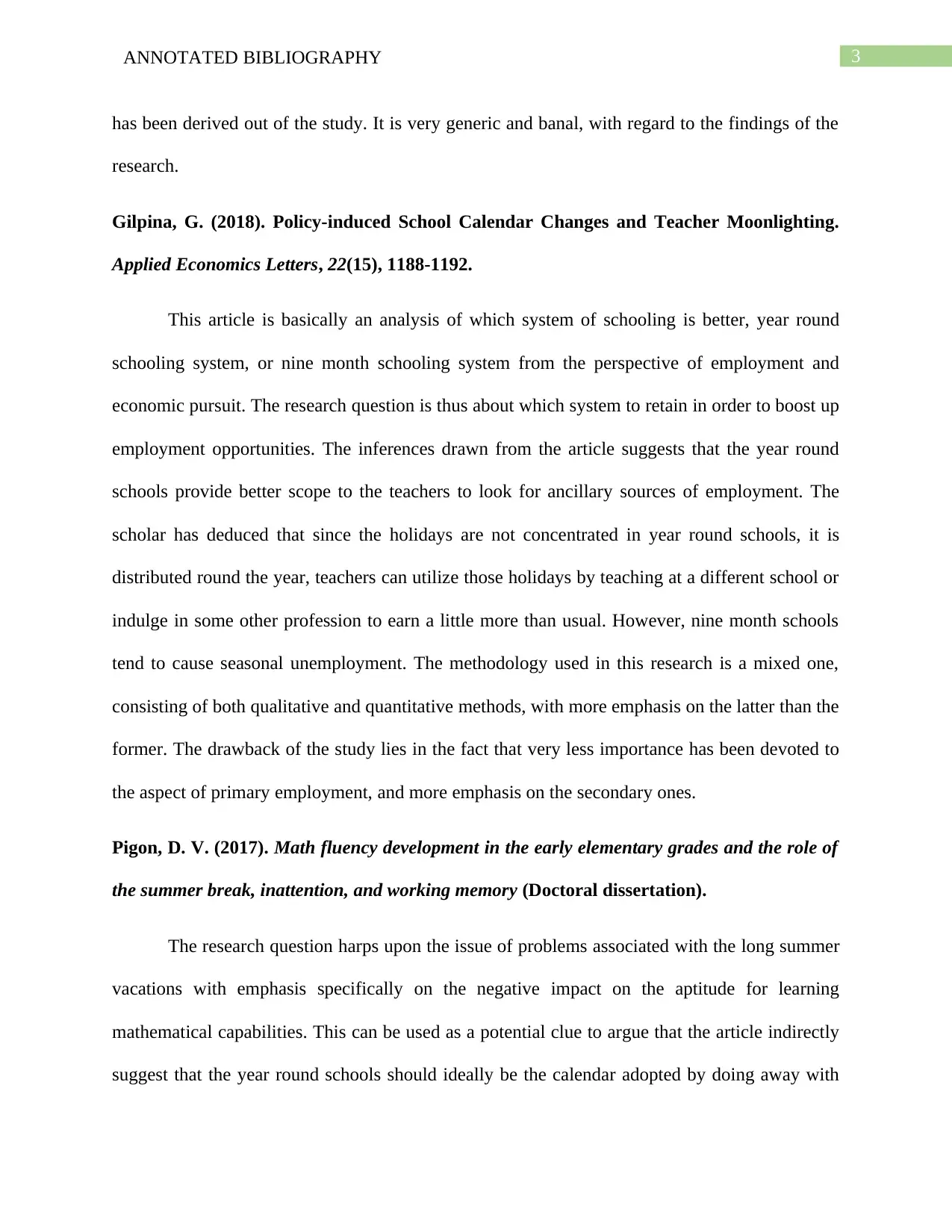
3ANNOTATED BIBLIOGRAPHY
has been derived out of the study. It is very generic and banal, with regard to the findings of the
research.
Gilpina, G. (2018). Policy-induced School Calendar Changes and Teacher Moonlighting.
Applied Economics Letters, 22(15), 1188-1192.
This article is basically an analysis of which system of schooling is better, year round
schooling system, or nine month schooling system from the perspective of employment and
economic pursuit. The research question is thus about which system to retain in order to boost up
employment opportunities. The inferences drawn from the article suggests that the year round
schools provide better scope to the teachers to look for ancillary sources of employment. The
scholar has deduced that since the holidays are not concentrated in year round schools, it is
distributed round the year, teachers can utilize those holidays by teaching at a different school or
indulge in some other profession to earn a little more than usual. However, nine month schools
tend to cause seasonal unemployment. The methodology used in this research is a mixed one,
consisting of both qualitative and quantitative methods, with more emphasis on the latter than the
former. The drawback of the study lies in the fact that very less importance has been devoted to
the aspect of primary employment, and more emphasis on the secondary ones.
Pigon, D. V. (2017). Math fluency development in the early elementary grades and the role of
the summer break, inattention, and working memory (Doctoral dissertation).
The research question harps upon the issue of problems associated with the long summer
vacations with emphasis specifically on the negative impact on the aptitude for learning
mathematical capabilities. This can be used as a potential clue to argue that the article indirectly
suggest that the year round schools should ideally be the calendar adopted by doing away with
has been derived out of the study. It is very generic and banal, with regard to the findings of the
research.
Gilpina, G. (2018). Policy-induced School Calendar Changes and Teacher Moonlighting.
Applied Economics Letters, 22(15), 1188-1192.
This article is basically an analysis of which system of schooling is better, year round
schooling system, or nine month schooling system from the perspective of employment and
economic pursuit. The research question is thus about which system to retain in order to boost up
employment opportunities. The inferences drawn from the article suggests that the year round
schools provide better scope to the teachers to look for ancillary sources of employment. The
scholar has deduced that since the holidays are not concentrated in year round schools, it is
distributed round the year, teachers can utilize those holidays by teaching at a different school or
indulge in some other profession to earn a little more than usual. However, nine month schools
tend to cause seasonal unemployment. The methodology used in this research is a mixed one,
consisting of both qualitative and quantitative methods, with more emphasis on the latter than the
former. The drawback of the study lies in the fact that very less importance has been devoted to
the aspect of primary employment, and more emphasis on the secondary ones.
Pigon, D. V. (2017). Math fluency development in the early elementary grades and the role of
the summer break, inattention, and working memory (Doctoral dissertation).
The research question harps upon the issue of problems associated with the long summer
vacations with emphasis specifically on the negative impact on the aptitude for learning
mathematical capabilities. This can be used as a potential clue to argue that the article indirectly
suggest that the year round schools should ideally be the calendar adopted by doing away with
Paraphrase This Document
Need a fresh take? Get an instant paraphrase of this document with our AI Paraphraser
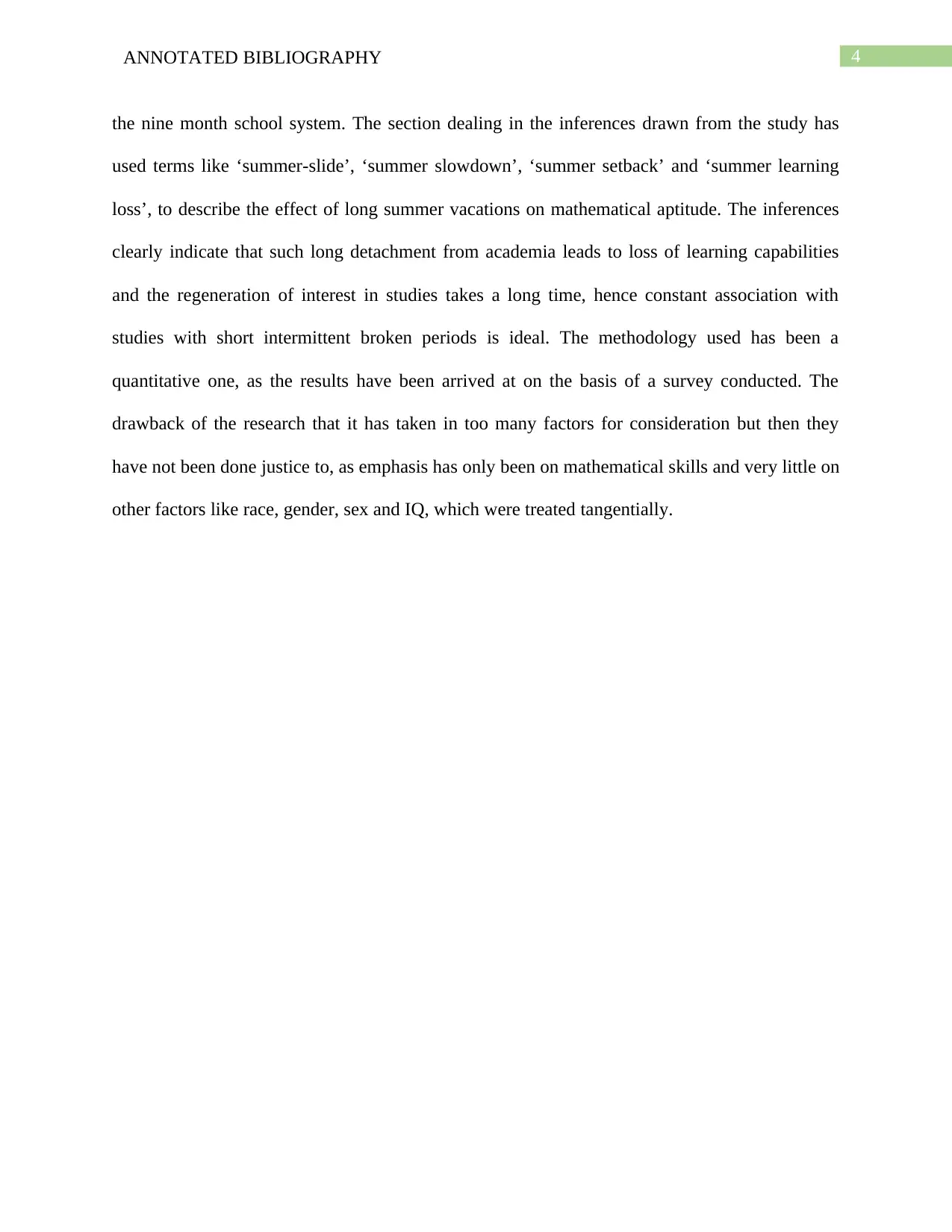
4ANNOTATED BIBLIOGRAPHY
the nine month school system. The section dealing in the inferences drawn from the study has
used terms like ‘summer-slide’, ‘summer slowdown’, ‘summer setback’ and ‘summer learning
loss’, to describe the effect of long summer vacations on mathematical aptitude. The inferences
clearly indicate that such long detachment from academia leads to loss of learning capabilities
and the regeneration of interest in studies takes a long time, hence constant association with
studies with short intermittent broken periods is ideal. The methodology used has been a
quantitative one, as the results have been arrived at on the basis of a survey conducted. The
drawback of the research that it has taken in too many factors for consideration but then they
have not been done justice to, as emphasis has only been on mathematical skills and very little on
other factors like race, gender, sex and IQ, which were treated tangentially.
the nine month school system. The section dealing in the inferences drawn from the study has
used terms like ‘summer-slide’, ‘summer slowdown’, ‘summer setback’ and ‘summer learning
loss’, to describe the effect of long summer vacations on mathematical aptitude. The inferences
clearly indicate that such long detachment from academia leads to loss of learning capabilities
and the regeneration of interest in studies takes a long time, hence constant association with
studies with short intermittent broken periods is ideal. The methodology used has been a
quantitative one, as the results have been arrived at on the basis of a survey conducted. The
drawback of the research that it has taken in too many factors for consideration but then they
have not been done justice to, as emphasis has only been on mathematical skills and very little on
other factors like race, gender, sex and IQ, which were treated tangentially.
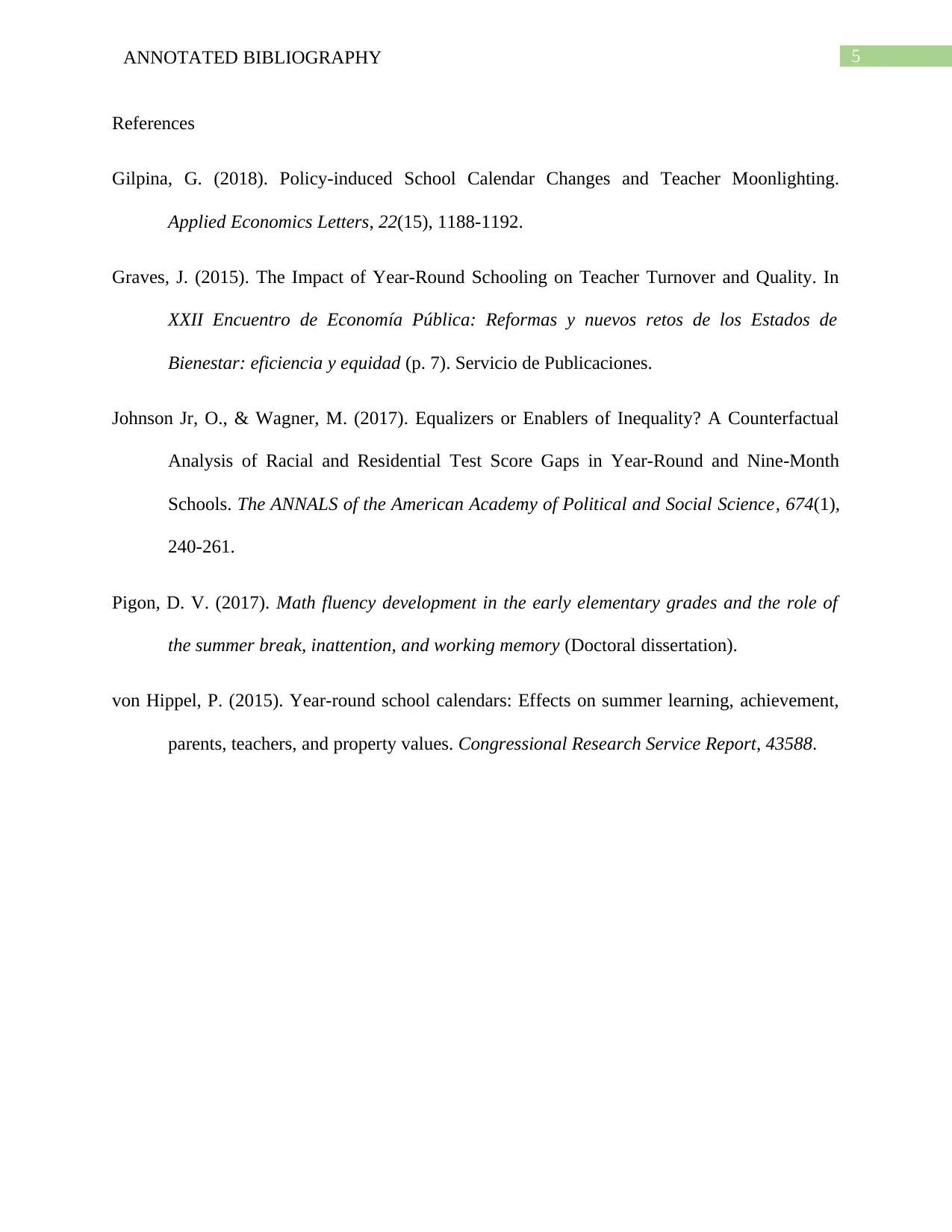
5ANNOTATED BIBLIOGRAPHY
References
Gilpina, G. (2018). Policy-induced School Calendar Changes and Teacher Moonlighting.
Applied Economics Letters, 22(15), 1188-1192.
Graves, J. (2015). The Impact of Year-Round Schooling on Teacher Turnover and Quality. In
XXII Encuentro de Economía Pública: Reformas y nuevos retos de los Estados de
Bienestar: eficiencia y equidad (p. 7). Servicio de Publicaciones.
Johnson Jr, O., & Wagner, M. (2017). Equalizers or Enablers of Inequality? A Counterfactual
Analysis of Racial and Residential Test Score Gaps in Year-Round and Nine-Month
Schools. The ANNALS of the American Academy of Political and Social Science, 674(1),
240-261.
Pigon, D. V. (2017). Math fluency development in the early elementary grades and the role of
the summer break, inattention, and working memory (Doctoral dissertation).
von Hippel, P. (2015). Year-round school calendars: Effects on summer learning, achievement,
parents, teachers, and property values. Congressional Research Service Report, 43588.
References
Gilpina, G. (2018). Policy-induced School Calendar Changes and Teacher Moonlighting.
Applied Economics Letters, 22(15), 1188-1192.
Graves, J. (2015). The Impact of Year-Round Schooling on Teacher Turnover and Quality. In
XXII Encuentro de Economía Pública: Reformas y nuevos retos de los Estados de
Bienestar: eficiencia y equidad (p. 7). Servicio de Publicaciones.
Johnson Jr, O., & Wagner, M. (2017). Equalizers or Enablers of Inequality? A Counterfactual
Analysis of Racial and Residential Test Score Gaps in Year-Round and Nine-Month
Schools. The ANNALS of the American Academy of Political and Social Science, 674(1),
240-261.
Pigon, D. V. (2017). Math fluency development in the early elementary grades and the role of
the summer break, inattention, and working memory (Doctoral dissertation).
von Hippel, P. (2015). Year-round school calendars: Effects on summer learning, achievement,
parents, teachers, and property values. Congressional Research Service Report, 43588.
⊘ This is a preview!⊘
Do you want full access?
Subscribe today to unlock all pages.

Trusted by 1+ million students worldwide
1 out of 6
Related Documents
Your All-in-One AI-Powered Toolkit for Academic Success.
+13062052269
info@desklib.com
Available 24*7 on WhatsApp / Email
![[object Object]](/_next/static/media/star-bottom.7253800d.svg)
Unlock your academic potential
Copyright © 2020–2025 A2Z Services. All Rights Reserved. Developed and managed by ZUCOL.





